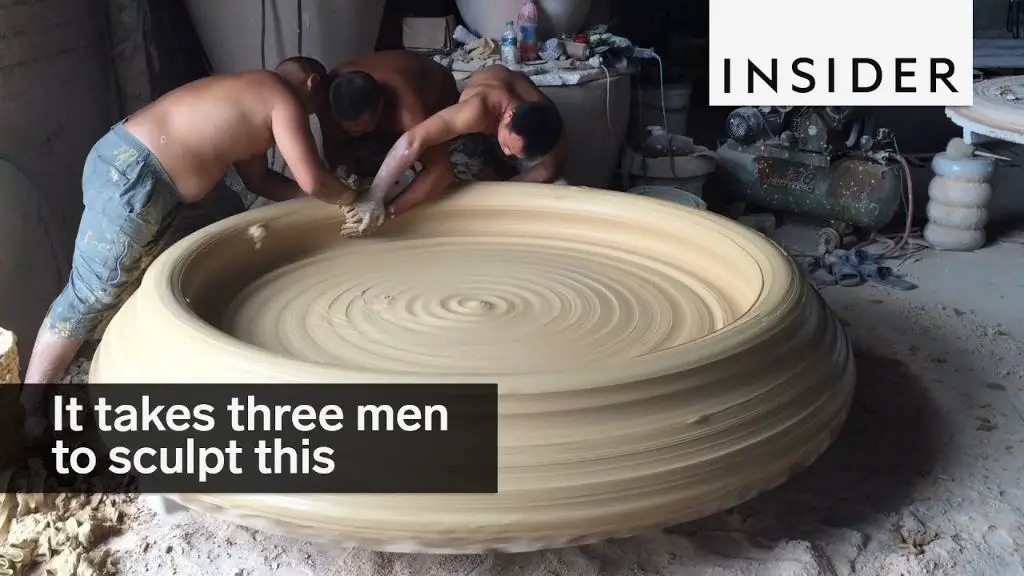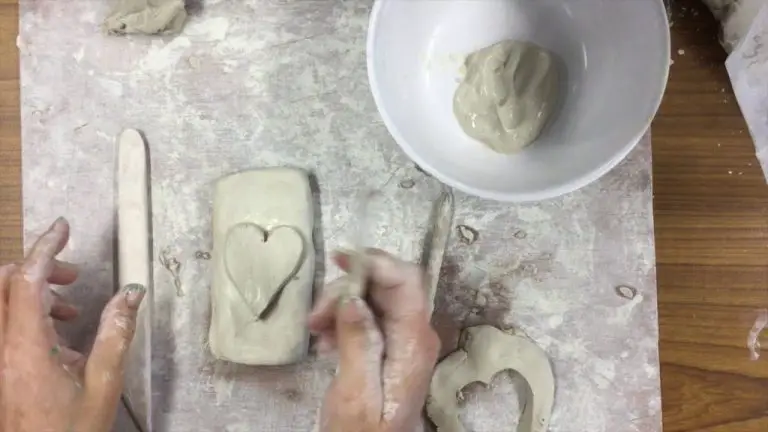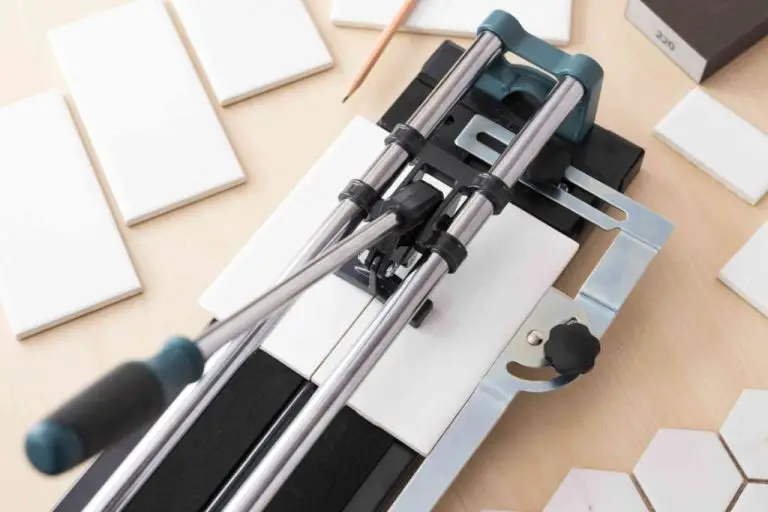What Is The Machine Called To Make Pottery?
What is a Pottery Wheel?
A pottery wheel, also known as a potter’s wheel, is a machine used to shape round ceramic ware. It consists of a spinning disk that the potter uses to form pots, bowls, vases, and other circular ceramic pieces.
The origins of the pottery wheel can be traced back over 5,000 years to ancient Mesopotamia, where the earliest known potter’s wheels were developed around 3500-3000 BCE. The technique spread across the ancient world, revolutionizing ceramic production. Before the wheel, pottery was made using coiling techniques that were much more time consuming. The spinning wheel enabled faster, more uniform production.
Today’s pottery wheels operate on the same basic principle as the ancient versions. The wheel head, or disk, spins rapidly while the potter uses their hands to mold wet clay that is placed in the center. The centrifugal force provided by the spinning helps shape the clay and allows the potter to raise and shape the walls evenly. As the potter’s hands press, pull, and smooth the clay, it takes on the intended form.
There are several types of pottery wheels used today by hobbyists, artists, and professional potters. The main categories are kick wheels, electric wheels, and treadle wheels. Kick wheels are spun by the potter continuously kicking a pedal. Electric wheels use electric motors for automated spinning. Treadle wheels use foot pedals attached to a crank mechanism.
Uses of a Pottery Wheel
The primary use of a pottery wheel is for creating pottery, ceramics and clay vessels such as bowls, cups, vases, pots, and more. The wheel enables a potter to efficiently shape clay into symmetrical round objects. It rotates while the potter uses their hands to mold the clay on top into the desired shape.
The momentum of the spinning wheel allows a skilled potter to quickly form clay into smooth, uniform pieces. Shaping pots and bowls by hand alone is extremely difficult and time consuming. A pottery wheel enables much faster production of rounded ceramics and pottery.
In addition to creating functional vessels and pots, a pottery wheel can also be used for sculpting clay into artistic shapes. The centrifugal force of the spinning wheel allows sculpting of clay into 3D forms that would be nearly impossible to achieve by hand sculpting alone.
Historically, the pottery wheel revolutionized ceramic production by allowing efficient, symmetrical, and standardized pottery creation. Before the wheel, free hand forming of clay vessels was extremely laborious. The wheel enabled civilization-changing mass production of ceramic pots, vessels, and sculptures.
Wheel Throwing

Wheel throwing is the process of using a pottery wheel to shape clay into pottery forms like bowls, vases, cups, and plates. It requires coordination between the potter’s hands and feet to center the clay on the wheel head and shape it into the desired form.
The steps in wheel throwing generally include:
- Centering – Centering the clay on the wheel head is crucial to ensure the clay doesn’t wobble. The potter applies even pressure with both hands while slowly rotating the wheel with the foot pedal until the clay is perfectly centered.
- Opening – Once centered, the potter uses their thumbs to press a hole into the top of the clay and open up the form.
- Raising the Walls – The potter places one hand inside the form and the other outside to pull the walls upwards and shape the basic form. The wheel spins at a steady speed during this process.
- Trimming – After the initial form is complete, excess clay is trimmed off with a special trim tool. Fine details may also be added at this stage.
Proper wheel throwing technique involves applying the right amount of pressure at each step so the clay maintains its shape without becoming too thin or collapsing.
Parts of a Pottery Wheel
A pottery wheel has several key parts that work together to shape clay into pottery:
The head holds the clay in place while spinning. It is the flat circular surface that the clay rests on during throwing. The wheel head is attached to the bat, which is the mount that connects to the wheel axle and allows the head to spin.
The wheel head is the actual spinning disk that the clay sits on. It can be made of various materials like plastic, metal or wood. Quality wheels often have bat pins to hold the bat firmly in place while throwing. Some wheel heads have splash pans built in to catch water and clay scraps.
Handrests provide stability and leverage while throwing. They are bars or disks placed on either side of the wheel head for the potter’s hands to brace against when centering or shaping the clay. Handrests can be fixed or adjustable.
The kick wheel uses foot power to spin the wheel head. Today most pottery wheels use an electric motor to provide consistent power and adjustable wheel speeds. Some wheels allow switching between kick wheel and electric motor.
According to this video, the key parts are the head, wheel head, handrests, and kick wheel/motor.
Types of Wheels
There are three main types of pottery wheels:
Kick Wheels
Kick wheels, also known as kickwheel pottery wheels, are manually operated by the potter kicking a lever with their foot to spin the wheel head. This type of wheel has been used for thousands of years and provides more direct control over the spinning speed. Kick wheels are inexpensive and portable options good for beginners learning wheel throwing (Source).
Electric Wheels
Electric pottery wheels use an electric motor to spin the wheel head at a consistent speed. The speed can be controlled with a foot pedal or knob. Electric wheels allow keeping both hands on the clay and provide smooth, continuous motion. They are the most popular type used by hobbyists and professionals today (Source).
Treadle Wheels
Treadle pottery wheels are powered by the potter continuously pumping a treadle with their foot to spin the wheel head. They provide more control than electric wheels but require more physical effort from the potter. Treadle wheels are less common today but offer a more traditional pottery experience.
Wheel Speeds
The speed at which the pottery wheel rotates is an important consideration, especially for beginners. According to Pottery Crafters, beginners should start with a slow wheel speed around 60-100 RPM to allow time to center the clay properly and maintain control while throwing. As skills improve, potters can increase the wheel speed up to 200-300 RPM for faster throwing. Faster speeds require quick reflexes and experience to control the clay.
The wheel speed is controlled via a foot pedal or switch on electric wheels. Kick wheels require rhythmic kicking by foot to maintain the speed. Kick wheels tend to have less control over precise speeds compared to electric wheels. No matter the type of wheel, controlling the speed is essential to prevent distortion or collapse while throwing clay.
Clays for Wheel Throwing
The type of clay used is an important factor in wheel throwing. The three main types of clay are stoneware, porcelain, and earthenware, each with their own properties that affect the throwing process.
Stoneware clays are very strong and durable at high temperatures. They have excellent plasticity, allowing potters to stretch and shape the walls of ware without tearing or slumping. Stoneware becomes vitrified and waterproof after firing above 2200°F. The high plasticity and durability make stoneware one of the most popular clays for throwing on the wheel.
Porcelain clays are extremely fine and smooth, giving a glass-like appearance after firing. Porcelain has excellent plasticity but is prone to warping and cracking during drying and firing due to the high shrinkage rate. Throwing porcelain requires great skill but can produce very delicate and translucent ware.
Earthenware clays are coarse textures and more porous than stoneware and porcelain. They have good plasticity but lower strength and shrinkage. Earthenware fires at lower temperatures (1875-2150°F) and results in more absorbent ware. The porous nature allows for unique glazing effects.
Considering the plasticity, workability, and firing requirements of the clay is key to successful wheel throwing. While porcelain can be difficult, stoneware offers an excellent balance of strength, plasticity and lower shrinkage for most throwers.
Wheel Throwing Tips
Proper technique is essential for throwing successful pots on the wheel. Here are some key wheel throwing tips for beginners:
Centering the clay properly is one of the most important steps. Well-centered clay will allow even wall thickness and stability while throwing. Use both hands to press the clay into a cone shape while applying downward pressure. Once centered, open the clay into a cylinder by placing thumbs down the center and slowly pressing outwards.[1]
As you open the walls, apply pressure evenly with both hands to maintain an even thickness. Use a rib tool to refine the inside and outside walls. Hold the rib lightly against the clay at a 45 degree angle and move smoothly from bottom to top. The rib will gently thin and smooth the walls.[2]
Maintain proper posture while throwing to avoid fatigue. Sit up straight with shoulders aligned over hips. Keep forearms level to avoid stress on wrists. Let legs support the movement rather than relying solely on back and arm muscles.[1] Proper posture will give you better control and stamina.
Common Pottery Wheel Terms
When working on a pottery wheel, there are some common terminology and tools to be aware of:
The bat is the surface that holds the clay as it is being thrown on the wheel. It is usually made of plaster or wood and sits on top of the wheel head. The bat provides a flat, secure base for the clay and can be removed from the wheel when the piece is complete for easy transport.[1]
A rib is a thin, rounded shaping tool used when throwing on the wheel. Ribs help compress the clay and smooth the interior and exterior walls of a thrown piece. They come in various sizes and materials like wood, rubber or metal.[2]
Slurry is a liquid clay mixture used to join two pieces of clay. It acts like glue and is brushed on the surfaces to be joined before fusing them together.[3]
Wedging is the process of kneading and working clay to remove air bubbles and evenly distribute moisture throughout the clay. Well wedged clay is essential for successful wheel throwing.[3]
Getting Started
If you’re new to wheel throwing, taking a beginner class can help you learn proper techniques from an experienced instructor. Many local art centers, colleges, or independent pottery studios offer introductory wheel throwing lessons. Having an expert observe you and provide feedback as you practice centering clay and pulling pots is invaluable when you’re just starting out.
Investing in the right pottery wheel is also important. Consider factors like wheel size, speed control, and budget when selecting your first wheel. Larger wheels around 12-18 inches are easier for beginners to center on. Variable speed control allows you to start slowly and increase speed as you advance. Expect to spend $300-$1000 for a decent beginner to intermediate level wheel. Brands like Shimpo and Brent are popular among hobbyist potters.
Make sure you have the proper basic pottery tools on hand before beginning to throw. At minimum, you’ll need wooden ribs for shaping, metal trimming tools, a sponge, cutting wire, a water bucket, and bats for transferring ware. As you progress, you can add more specialized tools to your toolkit. Taking a class often provides the tools you need to get started.
Mastering centering is the most important foundation skill for throwing pots on a wheel. Center your clay mound before opening and lifting the walls. Go slowly, applying even pressure as the wheel spins. Keep your elbows tucked in and watch the clay, not your hands. Practice centering every time you sit at the wheel, even if you don’t plan on making anything.
With some guidance from a teacher, quality wheel, tools, and patience, you’ll be creating beautiful thrown pieces in no time. Consistent practice develops the muscle memory and skills needed to successfully use a pottery wheel.


